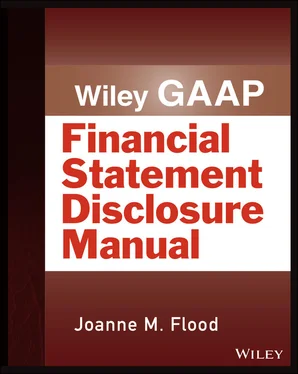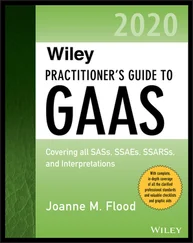Marketable securities representing the investment of cash available for current operations.
Receivables include accounts and notes receivable, receivables from affiliated entities, and officer and employee receivables. The term “accounts receivable” is generally understood to represent amounts due from customers arising from transactions in the ordinary course of business (sometimes referred to as “trade receivables”).
Inventories are goods on hand and available‐for‐sale, raw materials, work in process, operating supplies, and ordinary maintenance materials and parts. The basis of valuation and the method of pricing are to be disclosed.
Prepaid expenses are amounts paid in advance to secure the use of assets or the receipt of services at a future date. Prepaid expenses will not be converted to cash, but they are classified as current assets because, if not prepaid, they would have required the use of current assets during the coming year or operating cycle, if longer. (ASC 205‐10‐ 45‐2) Prepaid rent and prepaid insurance are the most common examples of prepaid expenses.(ASC 210‐10‐45‐1)
Noncurrent AssetsASC 210‐10‐45‐4 excludes the following from current assets:
Cash and claims to cash that are:Restricted as to withdrawal or use for other than current operations,Designated for expenditure in the acquisition or construction of noncurrent assets, orSegregated for the liquidation of long‐term debts.Even though not actually set aside in special accounts, funds that are clearly to be used in the near future for the liquidation of long‐term debts, payments to sinking funds, or for similar purposes shall also, under this concept, be excluded from current assets. However, if such funds are considered to offset maturing debt that has properly been set up as a current liability, they may be included within the current asset classification.
Receivables arising from unusual transactions (such as the sale of capital assets, or loans or advances to affiliates, officers, or employees) that are not expected to be collected within 12 months.
Investments that are intended to be held for an extended period of time (longer than one operating cycle). The following are the three major types of long‐term investments:Investments in securities––stocks, bonds, and long‐term notes receivable. Securities that are classified as available‐for‐sale or held‐to‐maturity investments are classified as long term if the entity intended to hold them for more than one year.Tangible assets not currently used in operations (e.g., land purchased as an investment and held for sale).Investments held in special funds (e.g., sinking funds, pension funds, amounts held for plant expansion, and cash surrender values of life insurance policies).
Depreciable assetsProperty, plant, and equipment. These are disclosed with related accumulated depreciation/depletion.Intangible assets include legal and/or contractual rights that are expected to provide future economic benefits and purchased goodwill. Patents, copyrights, logos, and trademarks are examples of rights that are recognized as intangible assets.Other assets. An all‐inclusive heading that incorporates assets that do not fit neatly into any of the other asset categories (e.g., long‐term prepaid expenses, deposits made to purchase equipment, deferred income tax assets (net of any required valuation allowance), bond issue costs, noncurrent receivables, and restricted cash).
Presenting significant amounts separately is good practice.
LiabilitiesLiabilities are displayed on the statement of financial position in the order of expected payment.
Current LiabilitiesObligations are classified as current if their liquidation is reasonably expected to require the use of existing resources properly classifiable as current assets or to create other current obligations. (ASC 210‐10‐45‐6) Current liabilities also includes obligations that are due on demand or that are callable at any time by the lender. These are classified as current regardless of the intent of the entity or lender. ASC 470‐10‐45 includes more guidance on those and on short‐term debt expected to be refinanced. (ASC 205‐10‐45‐7) The following items are classified as current liabilities:
1 Accounts payable
2 Trade notes payable
3 Current portion of obligations under leases
4 Accrued expenses
5 Income taxes
6 Derivative liabilities
7 Dividends payable
8 Advances and deposits
9 Agency collections and withholdings
10 Current portion of long‐term debt
11 Other liabilities(ASC 210‐10‐45‐8 and 45‐9)
Noncurrent liabilitiesObligations that are not expected to be liquidated within one year (or the current operating cycle, if longer) are classified as noncurrent. The following items would be classified as noncurrent:
1 Notes and bonds payable.
2 Lease obligations.
3 Written put options on the option writer's (issuer's) equity shares and forward contracts to purchase an issuer's equity shares that require physical or net cash settlement are classified as liabilities on the issuer's statement of financial position. The obligation is classified as noncurrent unless the date at which the contract will be settled is within the next year (or operating cycle, if longer).
4 Certain financial instruments that embody an unconditional obligation to issue a variable number of equity shares and financial instruments other than outstanding shares that embody a conditional obligation to issue a variable number of equity shares The obligation is classified as noncurrent unless the date at which the financial instrument will be settled is within the next year (or operating cycle, if longer).
5 Contingent obligations are recorded when it is probable that an obligation will occur as the result of a past event. The classification of a contingent liability as current or noncurrent depends on when the confirming event will occur and how soon afterward payment must be made.
6 Mandatorily redeemable shares are recorded as liabilities per ASC 480. A mandatory redemption clause requires common or preferred stock to be redeemed (retired) at a specific date(s) or upon occurrence of an event which is uncertain as to timing although ultimately certain to occur. The obligation is classified as noncurrent unless the date at which the shares must be redeemed is within the next year (or operating cycle, if longer).
7 Other noncurrent liabilities include defined benefit pension obligations, postemployment obligations, and postretirement obligations. Deferred income taxes are liabilities to pay income taxes in the future that result from differences between the carrying amounts of assets and liabilities for income tax and financial reporting purposes.
Stockholders' Equity
1 Nonredeemable preferred stock
2 Common stock
3 Treasury stock
4 Additional paid‐in‐capital
5 Accumulated other comprehensive income
6 Noncontrolling interests in consolidated subsidiaries
Form of the Statement of Financial Position
The format of a statement of financial position is not specified by any authoritative pronouncement. Instead, formats and titles have developed as a matter of tradition and, in some cases, through industry practice.
Two basic formats are used:
1 The balanced format, in which the sum of the amounts for liabilities and equity are added together on the face of the statement to illustrate that assets equal liabilities plus equity.
2 The less frequently presented equity format, which shows totals for assets, liabilities, and equity, but no sums illustrating that assets less liabilities equal equity.
Those two formats can take one of two forms:
Читать дальше












